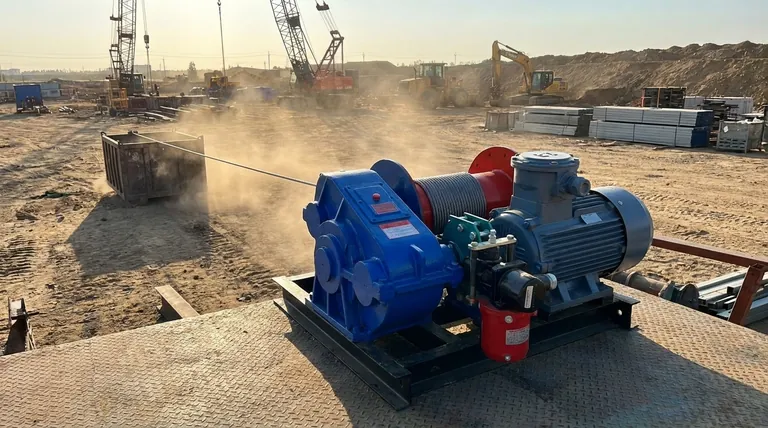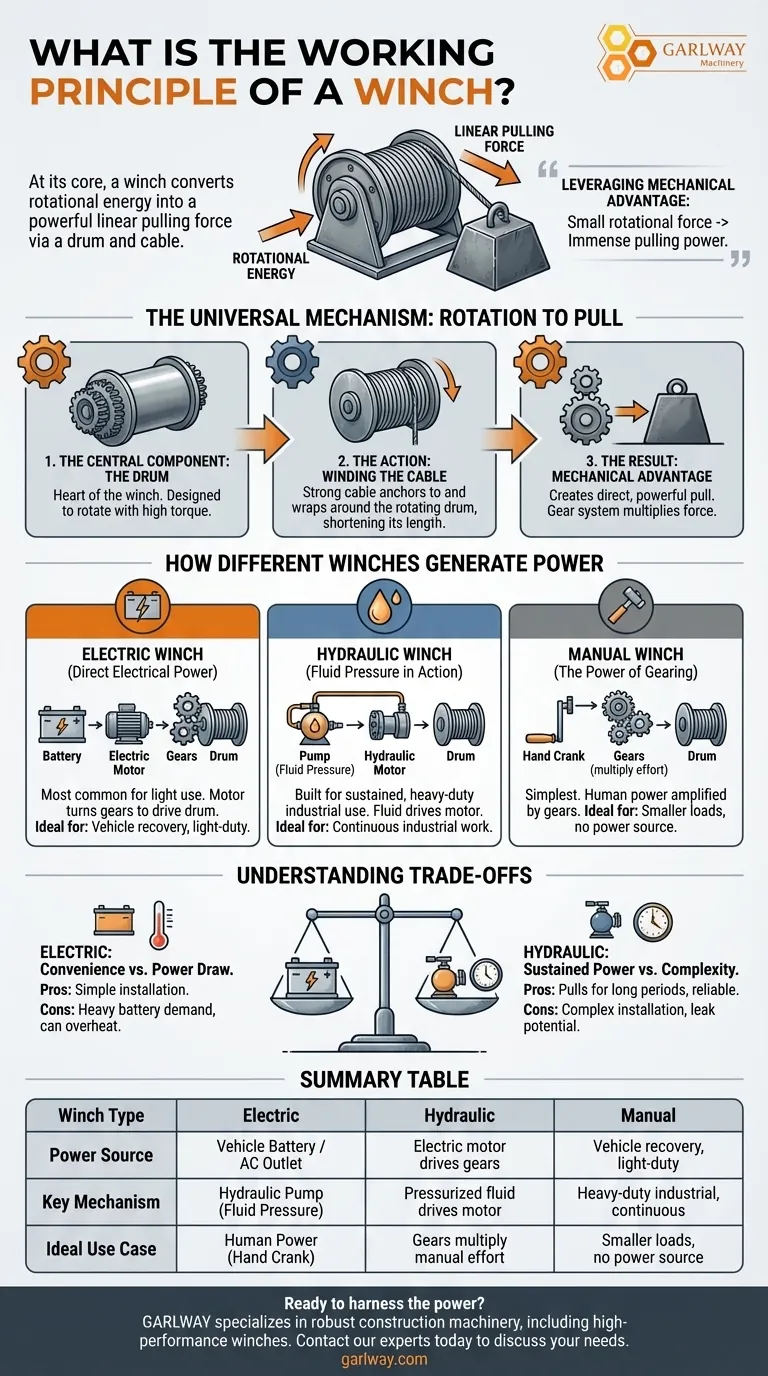At its core, a winch is a mechanical device that converts rotational energy into a powerful linear pulling force. It does this by using a power source—such as an electric motor, a hydraulic system, or a manual crank—to turn a drum. As the drum rotates, it winds a cable or rope around itself, effectively pulling any load attached to the end of that cable.
The fundamental principle of any winch is leveraging mechanical advantage. A small amount of rotational force applied to a drum is multiplied significantly, translating into the immense pulling power required to move heavy objects like vehicles or industrial equipment.

The Universal Principle: Rotation to Pulling Force
Regardless of the type, every winch operates on the same foundational concept. Understanding these core components reveals how the work gets done.
The Central Component: The Drum
The heart of the winch is a cylindrical drum. The entire mechanism is designed with one goal in mind: to make this drum rotate with high torque.
The Action: Winding the Cable
A strong wire rope or synthetic cable is anchored to and wrapped around the drum. When the drum rotates, it spools this cable, shortening its effective length.
The Result: Mechanical Advantage
This winding action creates a direct and powerful pull on the load attached to the cable's end. The gear system between the power source and the drum multiplies the force, allowing a small motor to pull a load many times its weight.
How Different Winches Generate Power
The primary difference between winch types lies in how they generate the rotational force to turn the drum. Each method has its own distinct mechanism.
The Electric Winch: Direct Electrical Power
Electric winches are the most common type for consumer and light commercial use. Their operation is straightforward.
Electricity, typically from a vehicle's battery (DC power) or a wall outlet (AC power), flows to an electric motor. Activating the winch causes this motor to turn, driving a series of gears that rotate the drum and wind the cable.
The Hydraulic Winch: Fluid Pressure in Action
Hydraulic winches are built for sustained, heavy-duty industrial applications. They harness the power of fluid dynamics.
These systems use a hydraulic pump, often driven by a vehicle's power steering system or a separate engine. The pump pressurizes hydraulic fluid (oil), which is then fed into a hydraulic motor. This pressurized fluid drives the motor, which in turn rotates the winch drum.
The Manual Winch: The Power of Gearing
The simplest winches use human power. A hand crank is connected to a series of gears (or sprockets).
When a person turns the crank, the gears multiply their effort significantly. This amplified force is then transmitted to the drum, allowing a single person to pull a surprisingly heavy load.
Understanding the Trade-offs
Choosing between winch types involves understanding their inherent limitations and strengths. There is no single "best" option; the right choice depends entirely on the application.
Electric Winch: Convenience vs. Power Draw
The main advantage of an electric winch is its relatively simple installation and operation. It can be run directly from a vehicle's electrical system.
However, it places a heavy demand on the battery and alternator, and can overheat during long, continuous pulls. This makes it ideal for intermittent use, like vehicle recovery.
Hydraulic Winch: Sustained Power vs. Complexity
A hydraulic winch can pull for long periods without overheating, making it the standard for industrial and commercial work where reliability under constant load is critical.
The downside is its complexity. It requires a hydraulic pump and fluid lines, making installation more involved and introducing more potential points of failure, such as fluid leaks.
Making the Right Choice for Your Goal
Your specific objective will determine which winch principle serves you best.
- If your primary focus is occasional vehicle recovery or light-duty pulling: An electric winch offers the best balance of power, convenience, and ease of installation.
- If your primary focus is continuous, heavy-duty industrial work or commercial towing: A hydraulic winch provides the sustained, reliable power needed for demanding, all-day operation.
- If your primary focus is moving smaller loads where no power source is available: A manual winch is a reliable, simple, and cost-effective solution.
Ultimately, understanding how a winch translates a simple rotation into powerful work empowers you to select the right tool for the job.
Summary Table:
| Winch Type | Power Source | Key Mechanism | Ideal Use Case |
|---|---|---|---|
| Electric | Vehicle Battery / AC Outlet | Electric motor drives gears to rotate drum | Vehicle recovery, light-duty pulling |
| Hydraulic | Hydraulic Pump (Fluid Pressure) | Pressurized fluid drives a hydraulic motor | Heavy-duty industrial, continuous operation |
| Manual | Human Power (Hand Crank) | Gears multiply manual effort to rotate drum | Smaller loads, no power source available |
Ready to harness the power of a reliable winch for your projects?
At GARLWAY, we specialize in providing robust construction machinery, including high-performance winches, concrete mixers, and batching plants. Whether you're a construction company or a contractor, our equipment is engineered for durability and efficiency in demanding environments.
Contact our experts today to discuss your specific needs and discover how GARLWAY can power your success.
Visual Guide

Related Products
- Electric and Hydraulic Winch for Heavy Duty Applications
- Warn Winch Windlass Boat Trailer Winch
- Electric 120V Boat Winch by Badlands
- Best 18000 Pound Drum Anchor Trailer Winch
- 12000 lb Heavy Duty Electric Boat Winch
People Also Ask
- How do I choose an electric winch? A guide to safe and effective pulling power.
- How long can you run an electric winch? Master Safe, Efficient Vehicle Recovery
- Can an electric winch be used as a hoist? Understand the Critical Safety Differences
- Can you use an electric winch manually? A Guide to Dual-Functionality Winches
- How is an electric winch powered? Unlock the Power Conversion System for Heavy Lifting



















